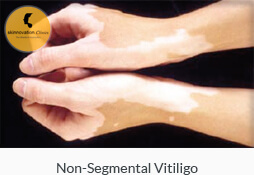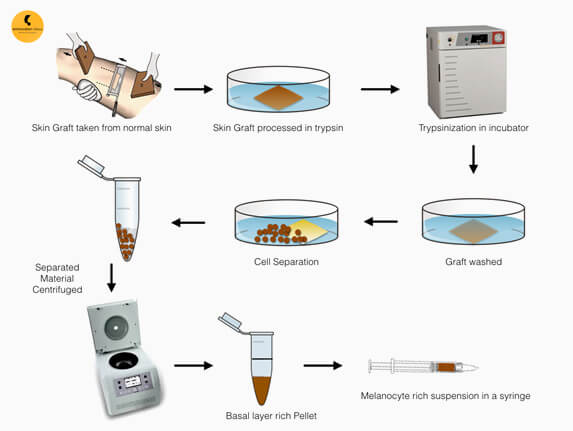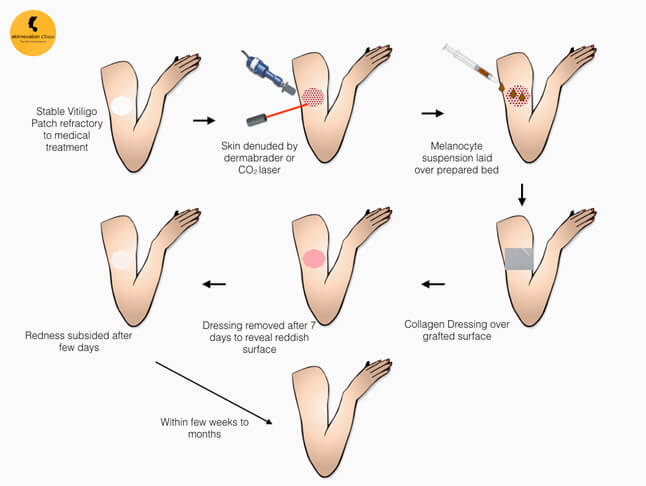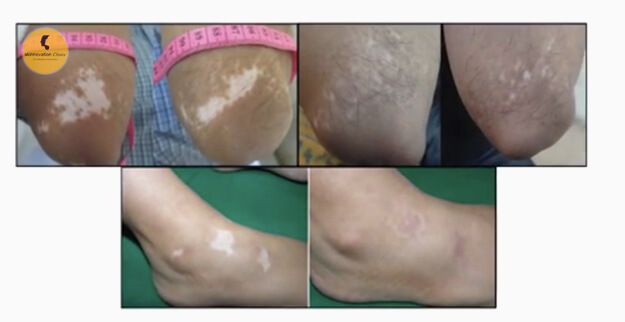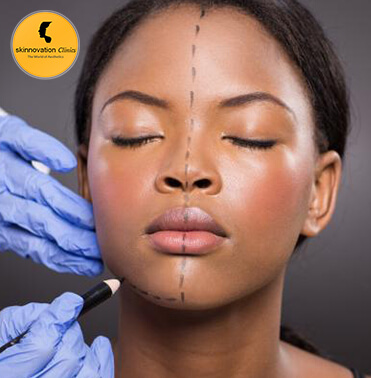What is Vitiligo?
Vitiligo is a condition in which areas of skin lose their normal pigment and become white. It is common, affecting about 1% of the world’s population. It can start at any age, but in about half of people affected it does so before 20 years of age. Its course is unpredictable, varying from single small patches to total loss of skin colour. In most people, it tends to progress slowly, with periods of stability often lasting several years. Skinnovation Clinics is among very few centre to offer Vitiligo Surgery & Melanocyte Transplant in Delhi.
What causes Vitiligo?
The pigment that gives your skin its normal colour is called melaninandis made by cells known as melanocytes. In patches of vitiligo the melanocytesare absent.The reason for this is not fully understood. However, vitiligo is considered to be an ‘autoimmune’ condition in which the body’s own immune system rejects some of its own cells (melanocytes in the case of vitiligo).As a result, thyroid disease and other autoimmune conditions are more common in individuals withvitiligo. There are multiple theories regarding causation of vitiligo apart from autoimmunity such as ‘Genetic tendency’, ‘Intrinsic defect of Melanocytes’, ‘Neural Theory’, ‘Oxidative Stress’ etc. All these theories have some basis and some evidence in favour of them. However, inspite of decades of research, we still don’t know the exact causation of melanocyte destruction in vitiligo.
Vitiligo affects men and women of all races equally, but is more noticeable in people with darkskins. It is not infectious. There is no medical evidence of any link between diet and vitiligo.
Is vitiligo hereditary?
Yes, vitiligo has a genetic basis, although only about a fifth of those with vitiligo know of someone in their family who also has it. If you have vitiligo, it does not necessarily follow that your children will developit.
Are there different types of Vitiligo?
Yes, two principal types: Segmental Vitiligo and Non-Segmental Vitiligo. These both behave very differently and are practically different phenotypes/diseases.
Segmental Vitiligo Surgery or Unilateral  Vitiligo
Vitiligo
It tends to affect areas of skin that are supplied by a specific nerve root and is most often unilateral. Often seen on a leg, face or arm, they are also associated with whitening of hair. It generally has an early onset, often advances for a year or so and then stops. It generally responds well to surgical treatment as its stability is predictable.
Non-segmental Vitiligo
It could be focal or generalised. Focal is generally the evolving stage of Segmental or Generalised Vitiligo. Generalized Vitiligo or Vitiligo Vulgaris occurs on both sides of the body (right and left). It may begin on the hands, fingertips, wrists, around the eyes or mouth, or on the feet. Individuals experience rapid loss of skin colour at the beginning, which then stops after a while, eventually leading to the repeated colour loss. This cycle usually continues all through a person’s lifetime. During the active stage, even trauma to skin might lead to depigmentation (Koebner’s Phenomenon). Colour loss tends to propagate, covering larger regions, thus increasing visibility. Acrofacial (involving tips of fingers and face) and Mucosal vitiligo (involving lips, genitalia) are also types of Generalised Non-Segmental vitiligo.
How is Vitiligo treated?
Vitiligo Surgery is treated with a combination of topical agents, phototherapy (PUVA or NB-UVB), immuno-modulators and surgery. Therapeutics is targeted at two aspects: Stabilisation of Disease Process (Cessation of ongoing depigmentation) and Re-Pigmentation (Formation of new pigment at the white areas). In stable disease, surgical strategies to re-pigment the white patches are often resorted to.
What is Melanocyte Transplantation?
Melanocyte transplantation is a surgical method which replenishes the melanocytes in the areas devoid of them. A thin, small piece of normally pigmented skin is obtained, usually from patient’s buttock/thigh. Through a highly specialised procedure, normal functioning melanocytes are separated from this piece of skin and made into a liquid suspension. This suspension is applied on to the white patches. Melanocytes, then start to proliferate and produce melanin and within a period of weeks to months, natural looking pigment covers the patches, making them indiscernible from the surrounding skin. This procedure is also called ‘non-cultured epidermal cell suspension transfer’ or ‘non-cultured cellular grafting’ or ‘melanocyte-keratinocyte transplantation procedure’.
How is Melanocyte Transplantation compared to other surgical procedures for vitiligo?
Other surgical procedures for vitiligo are Punch Grafting, Split-Thickness Skin Grafting and Suction Blister Epidermal Grafting. Compared to these methods, Melanocyte Transplantation has the distinct advantages of requiring a small piece of donor skin (about 1/4th to 1/10th the size of recipient patches) and resulting in the better colour match than other methods by providing pigmentation similar to that of surrounding skin. Melanocyte Transplantation is a specialised procedure requiring expertise, sophisticated techniques and devices.
Is the procedure of Melanocyte Transplantation painful?
The procedure is done under local anaesthesia where the skin operated upon is temporarily rendered sensation-less and no/minimal pain is felt during the procedure itself. A small piece of skin graft is taken from buttock/thigh (donor area) which is dressed immediately. The white patches are also similarly anaesthetised before they are prepared for application of melanocyte suspension. Thereafter they are covered with special dressing material. The dressing on both donor and recipient regions remain for about 7 days.
Will Melanocyte Transplantation instantly colour the white patches?
Melanocyte transplantation is a process of restoring the cells which produce pigment (Melanocytes) at the white patches of Vitiligo (which are devoid of them). After the procedure, the patches are covered with dressings for seven days. After seven days of healing, the operated area usually appears red. As the redness subsides, it appears white (as before the surgery). With suitable environment, nourishment and stimulation, the newly placed melanocytes start to produce pigment which eventually covers the whole patch. Pigmentation after a melanocyte transplantation typically starts appearing after few weeks. Within a span of four to six months, usually, we expect good coverage of the lesion with pigment. You may be advised certain medicated creams or phototherapy (NB-UVB) after 2-3 weeks of surgery to stimulate melanocytes.
Procedure for Melanocyte Transplantation
Who is the right candidate for melanocyte transplantation?
Patients with stable disease are the right candidates for melanocyte transplantation. We define stability as no new white lesions and no increase in size of old lesions for a minimum of 2 years. Also, features such as Koebner’s phenomenon (depigmentation at sites of trauma on skin), Keloid (large scars) formation should be absent in the ideal candidate. Thorough clinical examination, review of old treatment and photographic records are important for ascertain suitability for melanocyte transplantation. Generally, Segmental Vitiligo patients are known to respond best to melanocyte transplantation. Palms, Soles and Acrofacial Vitiligo (involving fingertips and region around mouth) are difficult to re-pigment.
Why choose us for Vitiligo Treatment?
Our specialist team of dermatologists and plastic surgeon has extensive experience in the field of vitiligo management. Our experts have trained at and performed path-breaking research in the field of vitiligo at centres of excellence in India and abroad. Our approach towards managing a patient of vitiligo is meticulous, evidence-based and in accordance with international guidelines. The therapies, reagents and protocols used by us are of international standards. We are ever-mindful regarding suitability of different treatments for different patients and try to tailor the treatment according to the patients’ needs and lifestyle. Melanocyte transplantation is a highly specialised procedure which requires unique set of skills and expertise. At Skinnovation Clinics-The world of Aesthetics, our team has consistently delivered good results with their standardised technique.
To book an appointment with Dr Sumit Gupta, Vitiligo Surgery in Dlehi, Call: +91- 9251711711

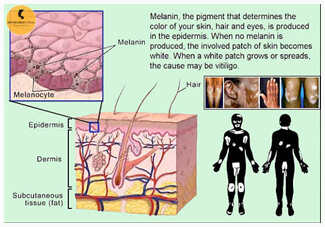
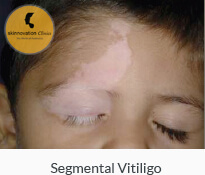 Vitiligo
Vitiligo